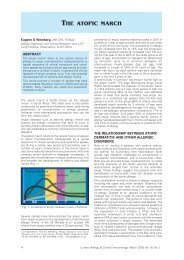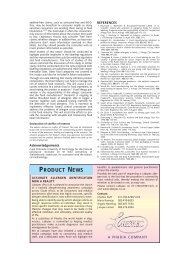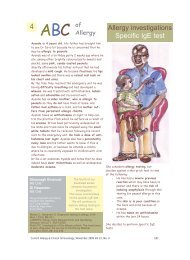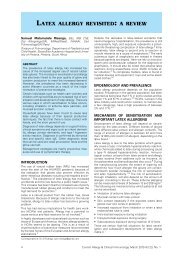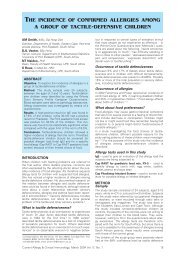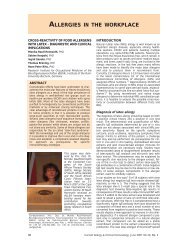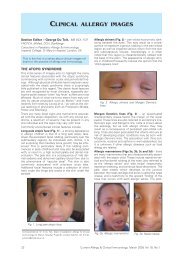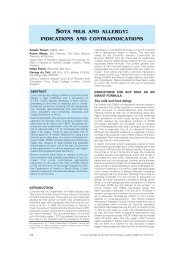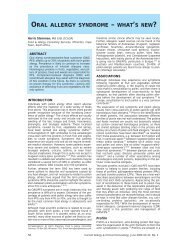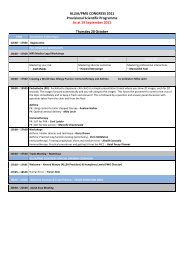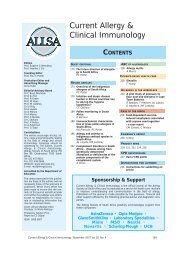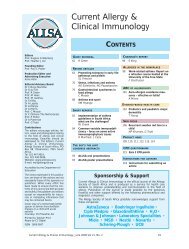Current Allergy and Clinical Immunology - March 2008
Current Allergy and Clinical Immunology - March 2008
Current Allergy and Clinical Immunology - March 2008
You also want an ePaper? Increase the reach of your titles
YUMPU automatically turns print PDFs into web optimized ePapers that Google loves.
Table II. Summary of exposure, clinical findings <strong>and</strong> patch test reactions for individual casesJob description Occupational exposure <strong>Clinical</strong> findings Patch testAllergenReaction1. Encapsulating Epoxy resin, thinners, mica Itchy, vesicular rash Epoxy resin (ESS) ?on arms, neck & Potassium dichromate (ESS) ?around eyes Clioquinol (ESS) 2+Fragrance mix (ESS) ?Epoxy resin (W) 1+2. Crane driver Epoxy resin, mica sheets Itchy rash on feet, Epoxy resin (ESS) 2+upper body & arms, Fragrance mix (ESS) 2+hyperpigmented areas Epoxy resin (W) 2+seen3. Process worker Epoxy resin, thinners, mica Itchy rash on dorsum Cobalt Chloride (ESS) 1–2+of h<strong>and</strong>s, arms & neck Epoxy resin (ESS) ?Nickel sulphate (ESS) 1+4. Process worker Epoxy resin, thinners, Itchy rash on neck, ESS Negmica & greaseface & forearms,swelling of eyes & face5. Armature winder Epoxy resins, thinners, Itchy, red rash & dry, ESS Negvarnish, Bostik putty, scaly skin on inner Epoxylite (W) ?IRthermosetting tape forearm Hot potting resin (Part A) (W) ?IR6. Encapsulating Epoxy resin, thinners, mica, Itchy rash on dorsum Epoxy resin (ESS) 1+heavy-duty h<strong>and</strong> cleaner of h<strong>and</strong>s, forearms, Epoxylite (W) 1+neck & eyelids,swelling of eyes7. Encapsulating Epoxy resin, thinners, Red, swollen eyes & Epoxy resin (ESS) 1+mica & greaseswollen lips, no visiblecontact dermatitis8. Core making Epoxy resins; powder coating, Itchy vesicular rash on Epoxy resin (ESS) ?Heavy-duty h<strong>and</strong> cleaner palmar & dorsal surfaceof h<strong>and</strong>s, & web spaces9. Coil taping Epoxy resin, thinners, mica Depigmented areas Epoxy resin (ESS) 2+around eyes & neck Nickel sulphate (ESS) 2+(Contact leucoderma)10. Apprentice Epoxy resin, cold glue, Dry, scaly, cracked skin Wool alcohols (ESS) ?pattern maker wood, thinners on h<strong>and</strong>s, starts as Paratertiary phenolitchy, vesicular rash formaldehyde resin (ESS) ?Reactions: Neg = negative; ? = questionable; 1+ = weak; 2+ = strong; 3+ = extreme; IR = irritant.Allergens: ESS = European St<strong>and</strong>ard Series; W = substances from the workplace.Airborne contamination must be controlled through theintroduction of adequate ventilation such as localexhaust ventilation. 13 In addition personal protectiveequipment should include safety glasses, face shield,<strong>and</strong> full face respirators depending on the extent ofexposure.Appropriate h<strong>and</strong> <strong>and</strong> body protection is required. Theglove material should be appropriate for the type ofchemical exposure. Latex gloves give good protectionagainst epoxy resins but only fair protection against thehardeners <strong>and</strong> solvents encountered. Ethyl vinyl alcohollaminate gloves on the other h<strong>and</strong> provide excellentprotection if used within the limits of the breakthroughtime. They should be replaced if damaged. 14 Chemicalresistantclothing, including disposable aprons, coveralls,lab coats <strong>and</strong> sleeves, should also be used. 13SUMMARYEpoxy resins cause dermatitis, both true allergic <strong>and</strong>irritant, leucoderma <strong>and</strong> urticaria. Health care workersshould be alert to the problems caused by these chemicals<strong>and</strong> should ensure that all possible cases are fullyassessed. It is important that optimum protectivemeasures should be instituted to protect all workersfrom these potentially dangerous substances.Declaration of conflict of interestThe authors declare no conflict of interest.REFERENCES1. Marks J, Elsner P, DeLeo V, eds. Contact & OccupationalDermatology. 3rd ed. Chapter 5 (St<strong>and</strong>ard Allergens). St Louis:Mosby Inc, 2002.2. Rietschel R, Fowler J, eds. Fisher’s Contact Dermatitis. 4th ed.Chapter 29 [Plastic (Synthetic Resin) Dermatitis]. Baltimore:Williams & Wilkins, 1995.3. Bray PG. Epoxy resins. Occup Med 1999; 14: 743-758.4. Gawkrodger DJ. Patch testing in occupational dermatology. OccupEnviron Med 2001; 58: 823-828.5. Chew AL, Maibach HI. Occupational issues of irritant contact dermatitis.Int Arch Occup Environ Health 2003; 76: 339-346.6. Jappe U, Geier J, Hausen BM. Contact vitiligo following a strongpatch test reaction to triglycidyl-p-aminophenol in an aircraft indus-<strong>Current</strong> <strong>Allergy</strong> & <strong>Clinical</strong> <strong>Immunology</strong>, <strong>March</strong> <strong>2008</strong> Vol 21, No. 1 41



